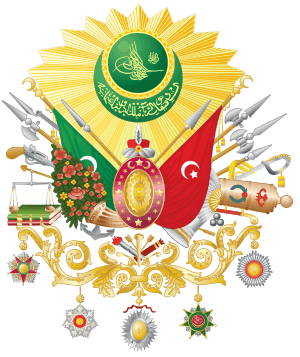Yaya (military)
Yaya or Piyade[3] were infantry military units of the Ottoman Empire and some other medieval Anatolian beyliks. Many of them were of Christian origin.[4]
| Yaya | |
|---|---|
| Active | 1325—? |
| Country | Ottoman Empire |
| Branch | Army |
| Type | Infantry |
| Engagements | Battle of Marica[1] Battle of Kosovo[2] Battle of Nicopolis[1] |
Part of a series on the |
|---|
| Military of the Ottoman Empire |
 |
|
Classical army (1451–1826) Kapıkulu (Janissaries · Six Divisions of Cavalry) · Sipahi · Voynuks Yamaks · Dervendjis · Sekban · Akinji · Azap · Levend · Timariots · Yaya · Humbaracı |
|
Modern army (1861–1922) |
|
|
| Conscription |
Name
Yaya means "pedestrian" in Ottoman Turkish. It is of Turkic origin word.[5] An alternative name, piyade, is derived from a Persian word with the same meaning.[6] This latter name was also used in the series of dynasties that ruled the neighboring Persian state.[7]
Background
The early Ottoman military forces consisted of irregular nomadic cavalry and volunteer light infantry.[7] These units were efficient against local Byzantine feudal lords but were unable to capture fortified castles by direct assault.[7] This was the reason for Alaeddin Pasha including the establishment of this unit in his proposal for reorganization the military of the Ottoman Empire made in the mid 1320s.[8][9] His brother, sultan Orhan, accepted his proposal and established yaya.[10]
Yaya were precursors of the Janissary corps of the Ottoman military, which would become one of the most influential and increasingly political forces in the Ottoman state until the 19th century.[11]Janissary Corps would be made of converted Christians from Balkans up to 1500(most of them Albanians, Bosnians and Eastern Romans). However by 1550s when the Devshirme was abolished " de facto" , the Janissary Corps would be dominated by muslim born Ottomans, majority of them being Muslim Albanians.
Organization
The commander of the Yaya unit was referred to as Yayabashi.[12] Members of this units were both Christian and Muslim citizens of the Ottoman Empire who were sometimes granted land estates in the Balkans in exchange for military service.[13] They were most irregular infantry Ottoman units because they usually served as armed laborers whose military skills were limited.[1] Still, before Janissary units were established and expanded in 1380s and afterwards, yaya peasant infantry had important military function.[14] By giving regular salary to yaya Ottomans acquired a standing army.[15]
Engagements
Among notable engagements of yaya military units are battles of Marica (1371) and Nicopolis (1396) where Ottoman infantry units, including yaya, were used to bait enemy heavy cavalry into an ambush between two flanks of more maneuverable light Ottoman cavalry.[1]
References
- Kelly DeVries; Robert Douglas Smith (1 January 2007). Medieval Weapons: An Illustrated History of Their Impact. ABC-CLIO. p. 206. ISBN 978-1-85109-526-1.
- Mesut Uyar; Edward J. Erickson (2009). A Military History of the Ottomans: From Osman to Atatürk. ABC-CLIO. p. 26. ISBN 978-0-275-98876-0.
The Yaya corps with light armor and problematic combat value was no match against heavily armored Balkan infantry in
- Abdul Rahim Abu Husayn (2004). The View from Istanbul: Ottoman Lebanon and the Druze Emirate. I.B.Tauris. p. 204. ISBN 978-1-86064-856-4.
- Armies of the Ottoman Turks 1300–1774. Osprey Publishing. 1983. p. 35. ISBN 978-0-85045-511-3.
Ottoman-Balkan Yaya, early 15th century: Many Ottoman infantrymen were of Christian origin and this seems to have been reflected in their equipment.
- https://www.nisanyansozluk.com/?k=yaya&view=annotated
- M. Th. Houtsma (1993). E. J. Brill's First Encyclopaedia of Islam, 1913–1936. BRILL. p. 572. ISBN 978-90-04-09790-2.
- Mesut Uyar; Edward J. Erickson (2009). A Military History of the Ottomans: From Osman to Atatürk. ABC-CLIO. p. 16. ISBN 978-0-275-98876-0.
- John McGilchrist (1856). A history of the Turks. p. 21.
Ala-ed-deen first embodied a corps called Yaya, or Piade. They were all infantry, and were raised and recruited from the body of the Ottoman population.
- Aziz Suryal Atiya; Eustache Deschamps; Philippe de Mézières (1934). The crusade of Nicopolis. Methuen & co., ltd. p. 73.
- David Nicolle (1995). The Janissaries. Osprey Publishing. p. 5. ISBN 978-1-85532-413-8.
- Konstantin Mihailović (1975). Memoirs of a Janissary. Published under the auspices of the Joint Committee on Eastern Europe, American Council of Learned Societies, by the Department of Slavic Languages and Literatures, University of Michigan. p. 204.
- Simēon (Dpir Lehatsʻi); George A. Bournoutian (2007). The travel accounts of Simēon of Poland. Mazda Publishers. p. 344. ISBN 978-1-56859-161-2.
yayabashi (T. yayaba§i): commanders of foot soldiers.
- Cathal J. Nolan (1 January 2008). Wars of the Age of Louis Xiv, 1650–1715. ABC-CLIO. p. 539. ISBN 978-0-313-35920-0.
- Jeroen Duindam; Tülay Artan; Metin Kunt (11 August 2011). Royal Courts in Dynastic States and Empires: A Global Perspective. BRILL. p. 306. ISBN 978-90-04-20622-9.
- H. J. Kissling; Bertold Spuler; N. Barbour; J. S. Trimingham; H. Braun; H. Hartel (1 August 1997). The Last Great Muslim Empires. BRILL. p. 6. ISBN 978-90-04-02104-4.
Since the infantrymen (yaya or piyade) received regular pay, the Ottoman state may be said to have acquired a standing army at this early date.